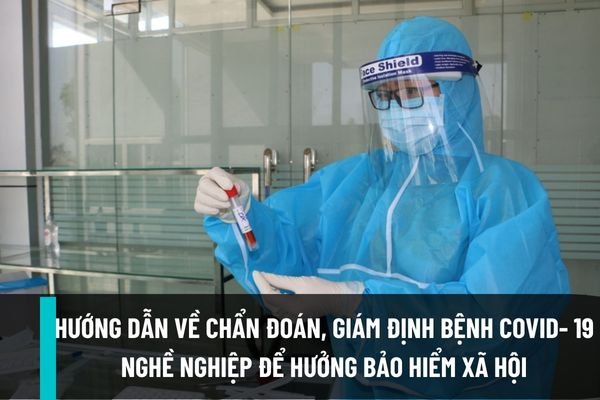Ministry of Health of Vietnam: What is the guidance on the diagnosis and assessment of occupational diseases related to COVID-19 for social insurance benefits?
What factors cause occupational COVID-19?
According to Section 2, Appendix 35 of the Guidelines for Diagnosing and Assessing Occupational COVID-19 issued with Circular 02/2023/TT-BYT, the factors causing occupational COVID-19 include:
- Exposure to the SARS-CoV-2 virus in the working environment.
- The pathogenic factor is recorded in one of the following documents:
+ Report on occupational exposure to the SARS-CoV-2 virus as stipulated in Appendix 36 issued with Circular 02/2023/TT-BYT
+ Document on participation in epidemic prevention, service, and assistance to SARS-CoV-2 virus-infected people signed and stamped by the unit leader, and other appropriate documents issued by competent state agencies.
+ Evaluation of occupational exposure factors stipulated in Section VI, Form 04, Appendix 3 issued with Decree 44/2016/ND-CP
+ Report confirming exposure to harmful factors causing acute occupational diseases as stipulated in Appendix 5 issued with Circular 28/2016/TT-BYT, dated June 30, 2016, of the Ministry of Health of Vietnam guiding the management of occupational diseases.

Ministry of Health of Vietnam: What is the guidance on the diagnosis and assessment of occupational diseases related to COVID-19 for social insurance benefits?
Vietnam: Which workers and occupations frequently come into contact with the SARS-CoV-2 virus?
According to Section 3, Appendix 35 of the Guidelines for Diagnosing and Assessing Occupational COVID-19 issued with Circular 02/2023/TT-BYT, the occupations and jobs frequently coming into contact with the SARS-CoV-2 virus include:
- Workers in medical facilities.
- Workers in laboratories, sample collection, transport, handling, preservation, and destruction of samples containing the SARS-CoV-2 virus.
- Workers in epidemic prevention, service, and assistance to SARS-CoV-2 virus-infected people, including:
+ Workers directly in centralized quarantine areas, home quarantine, medical quarantine in epidemic areas, supporting care for COVID-19 patients at home;
+ Workers transporting and serving COVID-19 patients;
+ Workers transporting, dressing, preserving, cremating, and burying the bodies of COVID-19 patients;
+ Workers supervising, investigating, and verifying the COVID-19 epidemic;
+ Customs officers, diplomats, immigration officers;
+ Officers, professional soldiers, non-commissioned officers, soldiers of the People's Army, national defense officials, defense workers, and public employees;
+ Police officers and soldiers;
+ Other workers assigned to participate in COVID-19 epidemic prevention.
What is the minimum exposure time and guaranteed time for harmful factors in the labor process to cause occupational diseases in Vietnam?
Based on Sections 4 and 5, Appendix 35 of the Guidelines for Diagnosing and Assessing Occupational COVID-19 issued with Circular 02/2023/TT-BYT, the guidance is as follows:
4. Minimum exposure time (the shortest exposure time to harmful factors in the labor process to cause occupational diseases): 01 (one) time.
5. Guaranteed time (the period from when the worker stops being exposed to the source of infection until the time of illness onset): 28 (twenty-eight) days.
The minimum exposure time is 01 time.
The guaranteed time from when the worker stops exposure to the source of infection until the time of illness onset is 28 (twenty-eight) days.
Ministry of Health of Vietnam: What is the guidance on the diagnosis and assessment of occupational diseases related to COVID-19 for social insurance benefits?
According to Section 8, Appendix 35 of the Guidelines for Diagnosing and Assessing Occupational COVID-19 issued with Circular 02/2023/TT-BYT, the guidance on diagnosing sequelae for occupational COVID-19 is as follows:
- General: prolonged symptoms such as fatigue (ICD-10: R53), joint pain (ICD-10: M25.5), muscle pain (ICD-10: M79.1), taste disorders (ICD-10: R43.1), smell disorders (ICD-10: R43.2), hair loss (ICD-10: L65).
- Respiratory: pneumonia (ICD-10: J12), interstitial pneumonia (ICD-10: J84), pulmonary embolism as fibrotic lung lesions (ICD-10: I26), emphysema, atelectasis, respiratory function decline (ICD-10: R06.8).
- Cardiovascular: arrhythmia (ICD-10: I49.9), myocarditis (ICD-10: I41.1), coronary artery infarction (ICD-10: I21), myocardial fibrosis (ICD-10: I42.3), chest pain (ICD-10: I20.9), hypertension (ICD-10: I15.8).
- Nervous system:
+ Movement paralysis (ICD-10: G83.9).
+ Cranial nerve paralysis (ICD-10: T90.3).
+ Epilepsy (ICD-10: G40).
+ Late-onset Guillain-Barré syndrome (ICD-10: G61.0).
+ Autoimmune encephalomyelitis after COVID-19 infection (ICD-10: B94.1).
- Mental health:
+ Organic hallucination (ICD-10: F06.0).
+ Organic catatonic disorder (ICD-10: F06.1).
+ Organic delusional disorder (similar to schizophrenia) (ICD-10: F06.2).
+ Organic manic disorder (ICD-10: F06.30).
+ Organic bipolar disorder (ICD-10: F06.31).
+ Organic depressive disorder (ICD-10: F06.32).
+ Organic mixed affective disorder (ICD-10: F06.33).
+ Organic anxiety disorder (ICD-10: F06.4).
+ Organic emotional instability disorder (nervous exhaustion) (ICD-10: F06.6).
+ Mild cognitive disorder (ICD-10: F06.7).
Note: Apply ICD-10 according to Decision No. 4469/QD-BYT on the issuance of the "International Classification of Diseases, ICD-10" and "Guide to Disease Coding According to ICD-10" at medical examination and treatment facilities.
Circular 02/2023/TT-BYT will be effective from April 1, 2023.
LawNet
